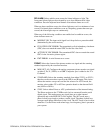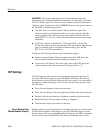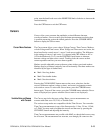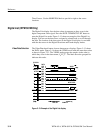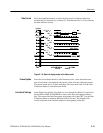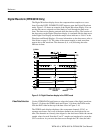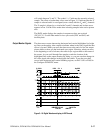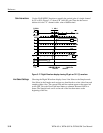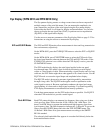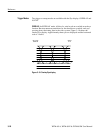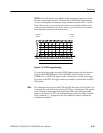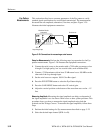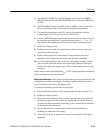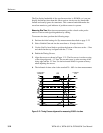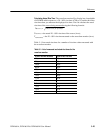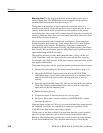
Reference
WFM 601A, WFM 601E & WFM 601M User Manual
3–19
Eye Display (WFM 601E and WFM 601M Only)
The Eye pattern display presents a voltage-versus-time waveform composed of
multiple sweeps of the serial bit stream. You can measure the amplitude, rise
time, aberrations, and jitter of the serial signal using the Eye pattern display.
Select either the Serial A or B input for display and measurement. You can also
choose to display the raw signal data (FLAT) or perform receiver equalization
(EQ EYE) on the signal before display.
Use the cursors to measure parameters of the Eye display. Refer to page 3–22 for
instructions on using the cursors to measure the Eye display.
The EYE and EYE EQ modes allow measurement in short and long transmission
line environments, respectively.
On the WFM 601E, press the EYE/EQ EYE button to select the EYE or EQ EYE
modes.
On the WFM 601M, press EYE/JITTER button to select the EYE mode. Press
the lower bezel button to alternate between the EYE and EQ EYE modes. If the
EYE/EQ EYE selection is not visible when the EYE display is active, press the
CLEAR MENU button.
The EYE mode directly displays the serial signal applied to the rear panel
loop-through input. This mode is best for directly monitoring a serial digital
source or a short length of cable. When monitoring a signal near the end of a long
cable run, the EYE mode might show what appears to be a band of noise. Use the
EQ EYE mode to restore the signal shape and amplitude before display.
The EQ EYE mode is best used to measure signals degraded by transmission
through a long cable. The EQ EYE mode applies receiver equalization to the
serial signal to restore it. Because equalization enhances the signal and causes
signal peaking, it is best used to check signal continuity. You should regard EQ
EYE display measurements as uncalibrated and merely qualitative.
For the best measurements, use the EYE mode whenever possible. Use EQ EYE
when the EYE mode fails to provide a useful signal.
Both EYE pattern displays can attenuate low frequency jitter using one of three
clock-recovery filters. Select from the 10 Hz, 100 Hz, and 1 kHz filters. Use
these Clock BW filters to separate the medium and high frequency jitter from
low frequency jitter. The filter frequencies indicate the –3 dB point. To access the
filters, press the CONFIG button and select the EYE PATTERN menu. The
10 Hz and 1 KHz filters allow jitter measurements according to the SMPTE
RP-184 standard.
The selected clock bandwidth filter appears in a readout field directly below the
horizontal deflection factor.
EYE and EQ EYE Modes
Clock BW Filters



